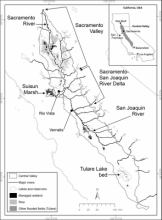Projected Impacts of Climate, Urbanization, Water Management, and Wetland Restoration on Waterbird Habitat in California’s Central Valley

The Central Valley of California is one of the most important regions for wintering waterbirds in North America despite extensive anthropogenic landscape modification and decline of historical wetlands there. Like many other mediterranean-climate ecosystems across the globe, the Central Valley has been subject to a burgeoning human population and expansion and intensification of agricultural and urban development that have impacted wildlife habitats. Future effects of urban development, changes in water supply management, and precipitation and air temperature related to global climate change on area of waterbird habitat in the Central Valley are uncertain, yet potentially substantial. Therefore, we modeled area of waterbird habitats for 17 climate, urbanization, water supply management, and wetland restoration scenarios for years 2006–2099 using a water resources and scenario modeling framework. Planned wetland restoration largely compensated for adverse effects of climate, urbanization, and water supply management changes on habitat areas through 2065, but fell short thereafter for all except one scenario. Projected habitat reductions due to climate models were more frequent and greater than under the recent historical climate and their magnitude increased through time. After 2065, area of waterbird habitat in all scenarios that included severe warmer, drier climate was projected to be >15% less than in the “existing” landscape most years. The greatest reduction in waterbird habitat occurred in scenarios that combined warmer, drier climate and plausible water supply management options affecting priority and delivery of water available for waterbird habitats. This scenario modeling addresses the complexity and uncertainties in the Central Valley landscape, use and management of related water supplies, and climate to inform waterbird habitat conservation and other resource management planning. Results indicate that increased wetland restoration and additional conservation and climate change adaptation strategies may be warranted to maintain habitat adequate to support waterbirds in the Central Valley.
Matchett, E. L., and J. P. Fleskes. 2017. Projected Impacts of Climate, Urbanization, Water Management, and Wetland Restoration on Waterbird Habitat in California’s Central Valley. PLOS ONE 12:e0169780.
